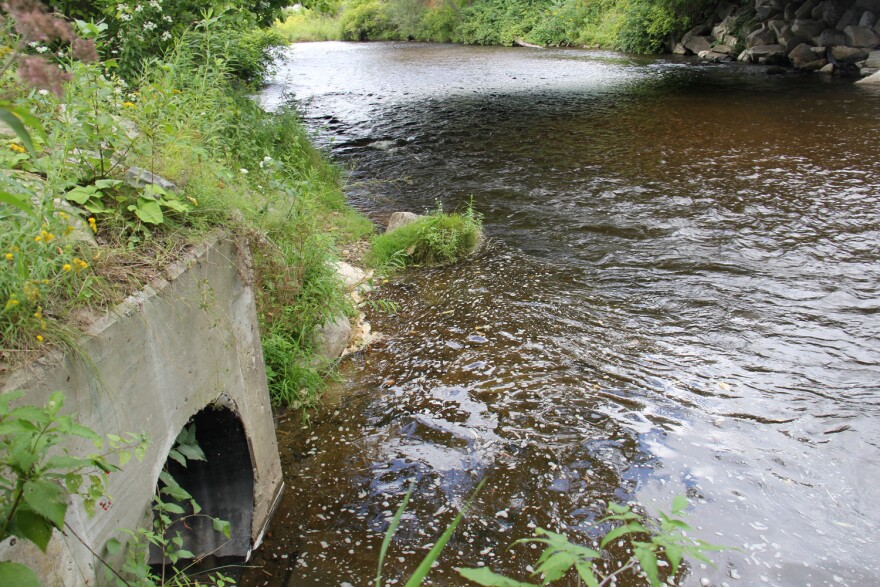Vermont lawmakers met with local and state officials Tuesday to try to figure out how to slow the flow of raw sewage into the state’s rivers and lakes.
The Burlington meeting, called by Vergennes Rep. Diane Lanpher, was focused on the issue of "combined sewer overflows" (CSOs), which happen when sewer systems that also collect stormwater are overwhelmed by heavy rains.
Lanpher said she began hearing more and more about the overflows in the rainy months of May and June that led to nearly two dozen sewage releases. She began asking around.
“I was speaking with my city council and people in Vergennes in the water district to find out just exactly what was going on, and was a little bit surprised myself to start to learn the scope of what has changed,” she said. “In the past, maybe Vergennes or these other communities maybe would have one or two discharges a year, but things have changed.”
So far this year, 33 combined sewer overflows have been reported to the state ranging from 12 to 1,186,400 gallons. Vergennes has been responsible for seven of those releases; Rutland for 12.
Only about half of the overflow points are connected to systems that meet the state's capacity requirements. - Vermont Department of Environmental Conservation
While the overflows are allowed, the Department of Environmental Conservation (DEC) sets limits for the amount of water that systems must be able to handle before overflowing. The goal of that policy is to prevent sewage systems from regularly dumping sewage into rivers or lakes.
“We set a standard in the CSO policy of 1990,” said DEC Watershed Management Chief Pete Laflamme. “A two-and-a-half inch storm over 24 hours, so that has about a two-year return period, so any given year there’s a 50 percent chance that a CSO will occur.”
In theory, any of the state’s 68 combined sewer system overflow points – generally a pipe at the edge of or below the surface of a waterway – should be overflowing less than once per year on average, but that’s not happening.
Part of the reason for that is, according to DEC, only about half of those overflow points are connected to systems that meet the state’s capacity requirements.
The 1990 policy that set those requirements has driven the number of combined sewer overflow points in the state down from 171 to 68.
“What that means is the remaining combined sewer overflow issues are much more expensive and difficult to deal with,” said DEC Commissioner Alyssa Schuren. “We have gotten the low-hanging fruit over the past 20-some odd years, so we’re left with the most expensive problems to deal with, and I think that’s worth noting.”
Even with just 68 remaining overflow points of the 171 that existed in 1990, officials said the total elimination of sewer overflows in Vermont could cost over $100 million.
"We came up with a real rough number, a ballpark number, and folks are going to cringe when they hear this, but we came up with about $2.5 million per CSO outflow point." - Pete Laflamme, Department of Environmental Conservation
“We came up with a real rough number, a ballpark number, and folks are going to cringe when they hear this, but we came up with about two to two-and-a-half million dollars per CSO outflow point,” Laflamme said at the meeting, noting that the actual numbers could be very different depending on project specifics.
The other costs of eliminating or reducing sewer overflows, officials warned, are all of the water quality efforts that could be funded with that money instead.
While sewage spills do have what Schuren calls a “yuck factor” and can create health hazards, they are not a significant source of the phosphorus lawmakers and state officials have spent most of the year trying to address. Phosphorus fuels potentially toxic algae blooms in Lake Champlain whereas sewage is a temporary health hazard in a very small area.
“So really what it boils down to for us – and folks say ‘Why haven’t you eliminated all the combined sewer overflows by now?’ It’s an issue of prioritization,” Laflamme said. “It’s an issue of trying to balance the magnitude of these events and their effects upon receiving waters with the total costs and all of the other pressures on cost.”
Schuren urged lawmakers to keep all aspects of water quality in mind – not just sewage overflows – when they outline their funding priorities in the spring.
“These are complex issues and sometimes when you have this type of public outcry around one issue, you think ‘Okay well we need to drill down and we need to give the couple hundred million just to solve this one thing,’” she said. “But we also need to think holistically about if we’re looking for clean water, where are we putting our resources? And if we want to deal with Vermont’s infrastructure problem, how will we do that?”




